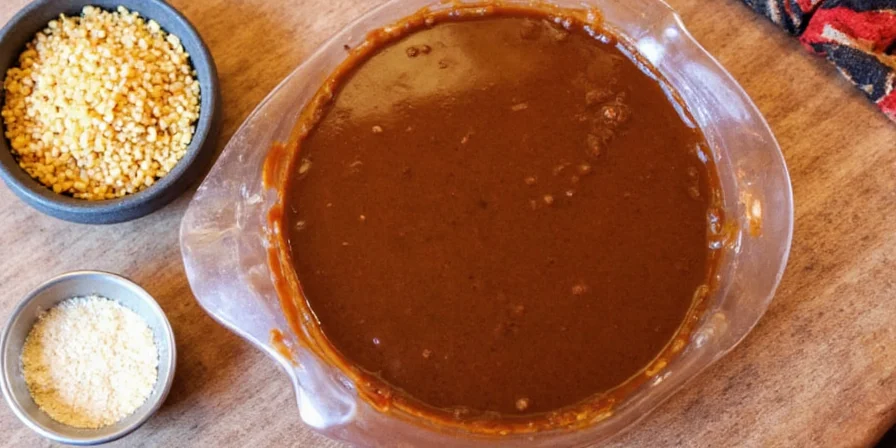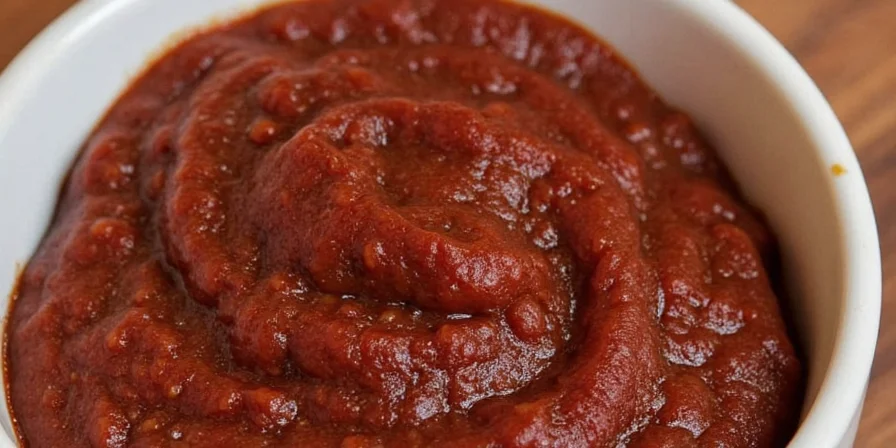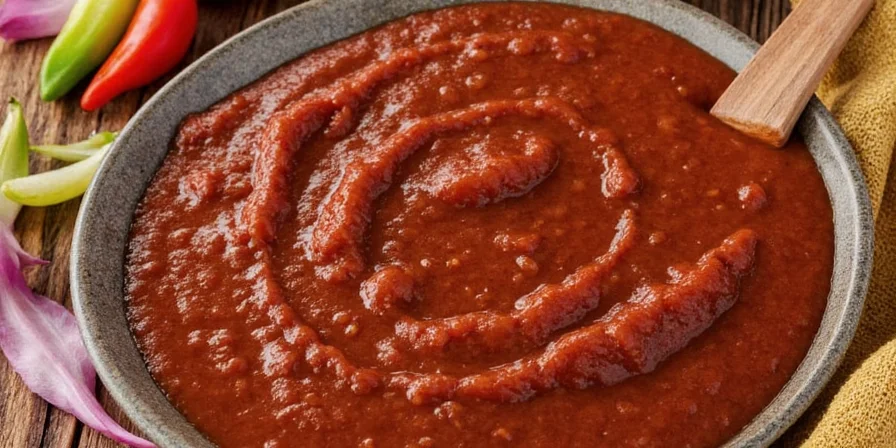Mole sauce is a complex, traditional Mexican sauce made from a blend of chilies, spices, nuts, seeds, and often chocolate. Despite common misconceptions, not all mole varieties contain chocolate—only specific types like mole poblano and mole negro include it. Authentic mole requires meticulous preparation involving toasting, grinding, and simmering multiple ingredients to create its signature depth of flavor.
This comprehensive guide answers the most common questions about mole sauce, including its authentic definition, regional varieties, key ingredients, and traditional preparation methods. You'll learn exactly what distinguishes genuine mole from imitations, how to identify different types, and practical tips for working with this celebrated Mexican culinary treasure.
Table of Contents
- What Exactly Is Mole Sauce? The Authentic Definition
- Mole Sauce History: Separating Fact from Legend
- The 6 Traditional Mole Varieties You Should Know
- Mole Sauce Ingredients Breakdown: What's Really Inside
- Authentic Mole Preparation: Step-by-Step Guide
- Perfect Food Pairings for Each Mole Type
- Surprising Mole Facts Backed by Culinary Tradition
- Why Authentic Mole Matters in Mexican Cuisine
What Exactly Is Mole Sauce? The Authentic Definition
Mole (pronounced "MOH-lay") is a complex sauce originating from Mexico, characterized by its blend of multiple ingredients including dried chilies, spices, nuts, seeds, and sometimes chocolate. The term "mole" comes from the Nahuatl word "mōlli," meaning sauce or concoction.
Contrary to popular belief outside Mexico, mole is not simply "chocolate sauce." While certain varieties incorporate chocolate, many traditional moles contain no chocolate at all. Authentic mole always features a carefully balanced combination of ingredients that create its distinctive flavor profile—simultaneously spicy, sweet, savory, and earthy.
Key Clarification:
True mole requires multiple ingredients (typically 20+) and extensive preparation. Commercial "mole paste" products often simplify the traditional process, resulting in less complex flavor profiles than authentic, freshly prepared mole.

Mole Sauce History: Separating Fact from Legend
Mole's origins trace back to pre-Hispanic Mexico, where indigenous communities created complex sauces using native ingredients like chilies, seeds, and herbs. After the Spanish arrival, new ingredients including spices, nuts, and chocolate were incorporated, evolving mole into the sophisticated sauce we recognize today.
While popular legend credits 17th century nuns in Puebla with inventing mole poblano for a visiting bishop, food historians note this oversimplifies mole's evolution. Traditional Mexican cooking techniques show mole developed gradually through cultural exchange, with regional variations emerging across different parts of Mexico.
The six states most associated with authentic mole traditions are Puebla, Oaxaca, Tlaxcala, Morelos, Guerrero, and Tlaxiaco, each with distinctive regional variations that reflect local ingredients and cultural influences.

The 6 Traditional Mole Varieties You Should Know
Understanding mole requires recognizing its regional diversity. The following table outlines the six most authentic mole varieties recognized in Mexican culinary tradition:
| Type | Color | Key Ingredients | Heat Level | Authentic Region |
|---|---|---|---|---|
| Mole Poblano | Dark Brown | Ancho & Mulato chilies, chocolate, sesame, almonds | Mild to Medium | Puebla |
| Mole Negro Oaxaqueño | Jet Black | Chilhuacle negro, plantain, chocolate, tortilla | Medium-High | Oaxaca |
| Mole Verde | Green | Pumpkin seeds, tomatillo, green chilies, fresh herbs | Medium | Oaxaca, Tlaxcala |
| Mole Coloradito | Reddish-Brown | Guajillo chili, ancho chili, plantain, sesame | Low-Medium | Oaxaca |
| Mole Amarillo | Yellow | Guajillo chili, tomatoes, hoja santa, plantains | Low-Medium | Oaxaca |
| Mole Manchamanteles | Reddish-Brown | Tomatillo, pineapple, guajillo chili, hoja santa | Medium | Puebla |

Mole Sauce Ingredients Breakdown: What's Really Inside
Authentic mole always contains multiple ingredient categories working in harmony. The following components create mole's distinctive complexity:
- Chilies: Form the flavor foundation (ancho, mulato, pasilla, guajillo, or chilhuacle)
- Nuts & Seeds: Add texture and richness (sesame, pumpkin, peanuts, almonds)
- Spices: Contribute aromatic complexity (cinnamon, cloves, anise, black pepper)
- Fruit Elements: Provide natural sweetness (plantain, raisins, tomatoes)
- Thickening Agents: Create proper consistency (tortillas, bread, crackers)
- Chocolate (in specific varieties): Adds depth, not sweetness (only in mole poblano and mole negro)

Authentic Mole Preparation: Step-by-Step Guide
Creating authentic mole requires patience and attention to detail. Here's the traditional preparation method used by Mexican culinary experts:
- Ingredient Preparation: Separate chilies from stems and seeds. Roast spices, nuts, and seeds individually until fragrant.
- Drying Process: Briefly fry dried chilies in oil to soften while preserving flavor. Toast tortillas or bread for thickening.
- Blending Sequence: Process ingredients in specific order: spices first, then nuts/seeds, followed by chilies, and finally liquid components.
- Straining: Pass through fine mesh sieve to achieve smooth texture essential to authentic mole.
- Simmering: Cook on low heat for 45-60 minutes, stirring frequently to prevent sticking and allow flavors to meld.
- Adjustments: Balance flavors with small amounts of sugar (if too bitter), vinegar (if too sweet), or salt (to enhance overall flavor).
- Resting: Let mole rest for 12-24 hours before serving to allow full flavor development.

Perfect Food Pairings for Each Mole Type
Each mole variety complements specific foods based on traditional Mexican pairings:
- Mole Poblano: Traditionally served with turkey or chicken, especially for celebrations. The rich sauce balances perfectly with poultry's mild flavor.
- Mole Negro: Best with chicken or turkey, often accompanied by white rice and warm tortillas to absorb the complex sauce.
- Mole Verde: Pairs beautifully with chicken or pork, and works exceptionally well as an enchilada filling.
- Mole Coloradito: Complements chicken or turkey, and is traditionally served with rice and warm tortillas.
- Mole Amarillo: Excellent with chicken, often served alongside grilled vegetables.
- Mole Manchamanteles: Unique pairing with pork or chicken and pineapple, creating a sweet-savory combination.

Surprising Mole Facts Backed by Culinary Tradition
These authentic details separate genuine mole knowledge from common misconceptions:
- The most complex traditional mole recipes require up to 34 ingredients, though regional variations use fewer components.
- True mole negro gets its signature black color from charring tomatoes and chilies, not from excessive chocolate.
- In Oaxacan tradition, authentic mole preparation is often a community event where neighbors contribute specific ingredients.
- The chocolate in mole serves as a flavor enhancer, not a primary ingredient—it should never taste like dessert.
- Mole poblano was designated as part of Mexico's cultural heritage by the federal government in recognition of its cultural significance.

Why Authentic Mole Matters in Mexican Cuisine
Understanding what mole sauce truly is goes beyond ingredient lists—it represents Mexico's culinary heritage and the sophisticated blending of indigenous and European food traditions. Authentic mole requires significant time and skill to prepare properly, which explains why it's traditionally reserved for special occasions.
When prepared correctly, mole offers a complex flavor experience that evolves with each bite—starting with chili heat, developing into earthy nuttiness, and finishing with subtle sweetness. This complexity makes it one of the world's most sophisticated sauces, deserving recognition beyond its simplified commercial representations.
By understanding mole's true nature, regional variations, and preparation methods, you gain deeper appreciation for this culinary treasure that continues to define Mexican gastronomy.

Key Insight:
If your mole preparation takes less than 90 minutes, you're likely missing essential steps that create authentic flavor complexity. Traditional mole requires careful attention to each ingredient's preparation.
Frequently Asked Questions About Mole Sauce
What is the difference between mole poblano and mole negro?
Mole poblano features a dark brown color and includes chocolate for subtle sweetness, originating from Puebla. Mole negro, from Oaxaca, achieves its jet black color through charring ingredients like tomatoes and chilies, resulting in a more intense, smoky flavor profile without relying on chocolate for color.
Does authentic mole sauce always contain chocolate?
No, chocolate only appears in specific traditional varieties like mole poblano and mole negro. Many authentic moles—including mole verde, mole amarillo, and mole coloradito—contain no chocolate. The misconception that all mole includes chocolate stems from the popularity of mole poblano in international markets.
How spicy is traditional mole sauce?
Authentic mole focuses on flavor complexity rather than heat. Most traditional varieties range from mild to medium spiciness, with the heat balanced by other elements like nuts, seeds, and natural sweetness from ingredients like plantains. The spiciest traditional mole is mole negro, which still emphasizes flavor depth over intense heat.
What distinguishes authentic mole from commercial versions?
Authentic mole requires toasting, grinding, and simmering numerous fresh ingredients. Commercial versions often use pre-made pastes with fewer ingredients and artificial additives. The most significant difference is in texture and flavor complexity—authentic mole has layered flavors that evolve as you eat, while commercial versions taste one-dimensional.
How should authentic mole be served according to Mexican tradition?
Traditional serving methods pair specific mole varieties with complementary foods: mole poblano with turkey for special occasions, mole verde with chicken enchiladas, and mole negro with chicken and rice. The sauce should be warmed properly and served at the right consistency—neither too thick nor too thin—to properly coat the food without overwhelming it.











 浙公网安备
33010002000092号
浙公网安备
33010002000092号 浙B2-20120091-4
浙B2-20120091-4